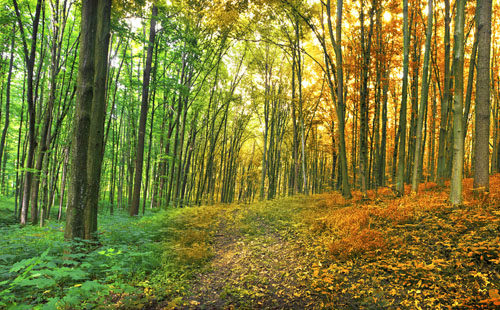HELP FOR YOUR WOODS ANYTIME
By Perry Brannan
ODNR Service Forester
The wooded areas on almost any property could provide better wildlife habitat and grow better timber with just a little help at the right time. Every season brings opportunities to improve your woodland.
Some tasks can be done only at certain times. Bare-root seedlings must be planted in the dormant season. Foliar herbicides work only after full leaf development in the spring and before autumn color sets in. Basal-bark treatments cannot be done with snow or ice around the trees. Chainsaw work is easier in the winter.
If you plan to make the most of each season, you might be amazed at how much ·you can benefit your woods in just one year. This calendar proposes examples to help you make the most of your time in the woods.
These suggestions are intended mainly for southeast Ohio. In northern Ohio, the best times might be a few weeks earlier in the autumn, or a month later in the spring. Check your written forest management plan, and ask your ODNR service forester or your favorite local Tree Farm Inspector for more specific ideas.
January: Thin around desirable trees to enhance wildlife habitat and timber growth, and to produce firewood. Trees cut now can give you seasoned firewood for next winter.
February: Apply basal-bark herbicide to control multiflora rose. Ailanthus and other woody invasive species can be controlled on nice, sunny days in late winter. It’s easier to see through those thickets, and you can wear heavy clothes to protect yourself from thorns.
March: Plant native tree seedlings. Mark them with wire flags, or protect them with tree shelters.
April: Pull garlic mustard to allow for the survival of native wildflowers and beneficial fungi.
May: Double-glrdle cull trees to create dens and snags for wildlife and to increase the growth of desirable trees nearby.
June: Treat Oriental (Asian) bittersweet and other nonnative, invasive species. Cut stump, foliar, and basal-bark treatments all work during June to September, unless plants are drought stressed. Basal-bark applications work best below 85°F.
July: Apply grass-specific herbicide on Japanese stiltgrass to save native plants that provide food for wildlife.
August: Apply basal-bark herbicide to control paulownia and ailanthus taller than shoulder height. Apply foliar herbicide to non-native, invasive plants shorter than shoulder height. This will improve the growth of native trees that provide timber and wildlife habitat.
September: Mow, spray, and/or till to kill grass in spots where trees can be planted next spring. Order tree seedlings in the fall before the nurseries sell out of the species you need.
October: Apply foliar herbicide to control bush honeysuckle. After the native plants have dropped their leaves, you have a few weeks when the bush honeysuckle is still green. Properly mixed foliar herbicides will not harm your native trees.
November: Fell patches of sassafras, basswood, aspen, or black locust. They will re-sprout and provide great cover for deer, turkeys, rabbits, grouse, and songbirds.
December: Apply foliar herbicide on Japanese honeysuckle where it is tangled all over your raspberry, blackberry, sumac, dogwood, and other flowering shrubs. This can work wonders on a warm day in December after the native plants have dropped their leaves but the Japanese honeysuckle is still green.

